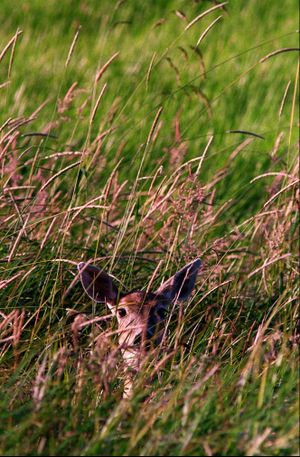Columbian whitetails poised for relisting from endangered to threatened
WILDLIFE -- After decades of federal protection, the Columbian white-tailed deer could be reclassified from “endangered” to “threatened."
The U.S. Fish and Wildlife Service, in its proposal, is characterizing the move as a success story, saying conservation efforts under the Endangered Species Act have helped bring the animal back from the brink.
Here are more details from the Associated Press:
Columbian white-tailed deer numbers have grown substantially since the 1960s, when they were first listed as endangered, in Southwest Washington and northwest Oregon. A separate population of white-tailed deer in Oregon’s Douglas County was removed from the endangered species list in 2003, the agency says.
The proposed downlisting of the deer won’t happen until next spring at the earliest, said Fish and Wildlife spokeswoman Elizabeth Materna. The agency is in a 60-day public comment period that ends Dec. 7, she said. After that, officials will consider the information they’ve received and evaluate whether it supports the move based on several factors, Materna said.
There are about 900 Columbian white-tailed deer around the Lower Columbia River. That’s a 10-year high, and about double the historic low point when the species was listed as endangered, said Paul Meyers, a wildlife biologist at the Julia Butler Hansen Refuge.
The population has seen sudden jumps and crashes in the past, which isn’t unusual for many species, including deer, Meyers said. The recent gains have been more gradual, he said, and that’s generally a good thing.
“This population increase looks a lot more sustainable than the last one,” Meyers said.
The Julia Butler Hansen Refuge, near Cathlamet, was established largely as a haven for Columbian white-tailed deer. More recently, the Ridgefield National Wildlife Refuge and surrounding area has become home to dozens of the animals. Most came during a three-year relocation project that moved the deer from the Julia Butler Hansen Refuge, where habitat was in danger of flooding due to a dike failure. That issue has since been fixed, Meyers said.
Many factors to consider
The deer at the Ridgefield refuge don’t always stay within its boundaries, said refuge biologist Alex Chmielewski. Some wander into private land, or even swim across the Columbia River to Sauvie Island, he said.
The number of fawns born in the area has more than made up for losses due to mortality, Chmielewski said.
“So far we’ve been successful, and I’m hopeful we’ll be able to maintain a secure population here into the future,” Chmielewski said.
The factors involved in a downlisting process include threatened habitat range, disease or predation, natural or human activities affecting its existence and other considerations, according to Fish and Wildlife.
Changing the white-tailed deer’s status from endangered to threatened would change the rules on interacting with them, Chmielewski said. If a deer caused agricultural damage, for example, a private landowner would have more options to haze or relocate the animal, he said.
A special rule proposed with the downlisting would also allow states, tribes and others more flexibility in moving the deer, Materna said.
Fish and Wildlife officials said they believe the downlisting is valid given the deer’s gains while under federal protection. The agency has taken on restoration efforts in partnership with the states of Washington and Oregon and the Cowlitz Indian Tribe.

